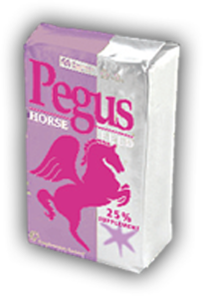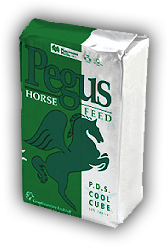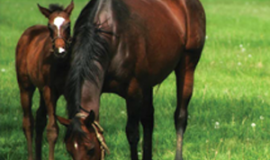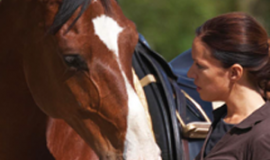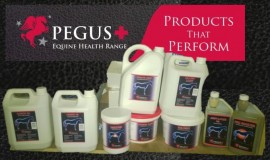Health Concerns Related to Equine Obesity
Body condition, adiposity, and weight can affect a horse’s overall health status. Here’s we’ll discuss some of the specific health concerns for horses that are too fat (obese).
Obesity is a serious health condition, but, unfortunately, many horse owners still look at a fat pony and think how cute it is, or look at a fat horse and compliment its big bone. However, science has now shown that adipose tissue (body fat) is more than merely a storage organ for fat (and therefore calories). It is an active tissue that secretes hormones and inflammatory proteins that can greatly affect an animal’s health.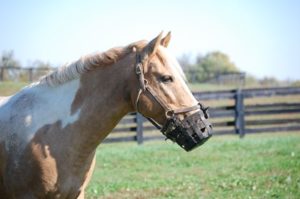
Incidence of Obesity in Horses
Obesity in our equine population is on the rise, similar to that in human, dog, and cat populations. In fact, in the late 1990s the National Animal Health Monitoring System (NAHMS) of the USDA estimated that only 5% of the horse population was obese. Recently, several studies have examined the current incidence of obesity in horses. A Scottish study found that 45% of 319 riding horses were considered “fat” or “very fat,” with 10% of those horses in the “very fat” category (Wyse et al., 2008). A Virginia study examined 300 horses and found that 51% of them were overweight and 19% (of the 300 horses) considered obese (Thatcher et al., 2007). A similar North Carolina study examined 366 horses and found that 48% of the horses scored a 6 or higher on the Henneke scale and 20% scored a 7 or higher (Owens et al., 2008). It is no surprise that obesity-related health conditions are also on the rise. An interesting secondary outcome of the Scottish study was that many horse owners did not believe their horses were obese. It is in fact common for horse owners to be very defensive about this topic. This further stresses the need for horse owners to learn how to score a horse’s body condition properly and understand the health consequences of obesity.
There are many reasons for the rise of obesity in horses. One of the biggest causative factors is the lack of owner education about equine nutrition. Surveys have shown that horse owners generate most of their nutrition knowledge from feed dealers rather than from independent nutritionists, academics (professors and researchers of equine nutrition), or veterinarians. There may be some discrepancy in what a feed dealer suggests a horse needs compared to what a nutritionist suggests. For example, a feed dealer may suggest the purchase of a special feed for a horse, while a nutritionist might determine that ordinary grain will suffice, or even that hay is enough. Also, many feeds are marketed to improve health or performance. Horse owners may take such advice too seriously and overfeed the product.
Overfeeding of concentrates is likely at least partially to blame for more horses becoming obese. The importance of concentrates in overall nutritional health is largely overrated for most horses, but any equine trade fair is inundated with feed company spokesmen pitching products most horses do not require, and owners are often enticed by the latest, greatest product.
Another factor that may contribute to increasing obesity rates is that the quality (in terms of nutritional density) of feeds is greatly increasing, especially pasture. Today’s pastures are mostly composed of plants intended for cattle and are too rich for horses.
Another factor contributing to obesity is owner perception of adiposity, and the fact that some disciplines, particularly halter classes, actually award horses that carry a bit of extra weight.
Lastly, horse owners often overestimate the amount of exercise their horses get and underestimate how much exercise a horse actually needs. Horses can easily handle hours and hours of low-intensity work; therefore, a 20–40 minute pleasure ride barely scratches the surface.
Health Issues Associated with Obesity
But what makes obesity a problem? As indicated, adipose (fat) tissue is no longer considered a mere calorie storage organ. In fact, adipose tissue is now regarded as a highly active metabolic organ that secretes hormones that play a major role in energy balance for the body and satiety (feeling full). Furthermore, adipose tissue produces inflammatory proteins called cytokines, which understanding your horse’s weight promote inflammation and can negatively affect the body. In fact, in humans, obesity is considered an inflammatory state due to the amount of inflammatory compounds produced by the adipose tissue. It is also believed that these cytokines play a role in causing oxidative stress, damaging tissues, and affecting metabolism, resulting in conditions such as heart disease and diabetes.
In horses, several health conditions have been associated with obesity, including laminitis. Laminitis is the inflammation of a network of blood vessels, known as the laminae, within the hoof—a very painful and often fatal condition. The inflammation reduces the laminae’s ability to integrate and hold the hoof wall and the coffin bone together. Thus, with severe laminitis it is possible for the coffin bone to rotate downward and protrude through the sole of the foot. Laminitis can be caused by a multitude of factors, including mechanical trauma (like road founder or uneven weight distribution, such as what affected Kentucky Derby winner Barbaro), dietary causes (such as following the consumption of high amounts of grain or rich grass), and metabolic causes. Metabolic causes of laminitis are those most likely associated with obesity, yet they are poorly understood. It is believed there is a complex interaction between cytokines and the vasculature (blood vessels within the hoof), resulting in inflamed laminae. In many cases, however, the laminitis is relatively minor and more of a chronic condition, termed founder. Also associated with this metabolic crisis is insulin resistance (discussed below). Insulin resistance, along with chronic founder, is often referred to as equine metabolic syndrome.
Insulin Resistance
Insulin resistance occurs when the hormone insulin does not effectively regulate blood glucose. In normal individuals, insulin functions to move glucose from the bloodstream into tissues such as skeletal muscle and adipose tissue. Insulin does this by triggering the movement of specific insulin-sensitive glucose transporters (called GLUT4) from within the cell to the cell membrane. Once these transporters are at the cell membrane, glucose can move from the blood into the cell.
Following a meal, the rise in blood glucose concentrations (due to digestion of carbohydrates and subsequent absorption of glucose within the small intestine) triggers the pancreas to release insulin. As mentioned above, insulin functions to facilitate movement of glucose from the bloodstream into various cells, thereby lowering blood glucose concentrations back to baseline. Horses that do not respond to the effects of insulin (which helps control blood sugar levels) are referred to as insulin resistant. In contrast, an individual with functioning insulin is said to be insulin sensitive. Insulin-resistant individuals cannot control their blood glucose concentrations. Therefore, after a meal blood glucose concentrations can be very high (hyperglycemia) and remain that way for several hours, causing the pancreas to secrete even more insulin in hopes of reducing blood glucose. The resulting high concentration of insulin in the blood (hyperinsulinemia) is a sign of insulin resistance. It is possible that eventually the pancreas can fatigue from its attempts to produce insulin and will reduce insulin production or potentially stop producing it altogether. This extreme situation is considered diabetes (when the pancreas cannot produce insulin, or does not produce enough) and appears to be relatively rare in horses. (Note: This scenario describes type II diabetes. In contrast, type I diabetes is a result of an autoimmune disorder in which the body’s own immune system attacks the pancreas and its ability to produce insulin. This is extremely rare in horses, though a horse was born with type I diabetes in Kentucky in October 2008.)
Insulin resistance in horses is likely caused by a variety of factors. One potential cause is diet-related. Depending on the composition of the diet, blood concentrations following a meal can vary greatly. For example, after a meal of “sweet feed” consisting of oats, corn, and molasses (high amounts of starch and sugar), there will be a much larger increase in blood glucose concentrations than after consuming a diet high in fiber or fat.
The increase in blood glucose following a meal is called the glycemic index (GI) and is a popular tool in human nutrition to quantify the glucose load of a meal. In equine nutrition the glycemic index of a feed is a little more difficult to quantify, in part because horses won’t eat as quickly as humans (time of consumption can greatly affect the GI, and horses can’t just be told to eat quickly). Nonetheless, in controlled studies, feeds such as cereal grains have been shown to have higher glycemic indices than feeds such as beet pulp, rice bran, or hay.
With respect to insulin resistance, it is believed that frequent peaks in blood glucose concentrations, and therefore insulin concentrations, dull the cellular receptors for insulin at the muscle or fat cell (think of living beside a train track: eventually with repeated stimulation you are dulled to the noise and don’t notice it anymore).
Science has proven that feeds higher in starch and sugar (and resulting in higher glycemic indices) lead to reduced insulin sensitivity compared to hay alone or feeds higher in fat and fiber (with lower glycemic indices) (Hoffman et al., 2003, Pratt et al., 2006).
Another important factor affecting insulin sensitivity is genetics. In human medicine, the quest for a “thrifty gene” is under way to prove that some genetic populations are more prone to obesity and metabolic conditions. It is well known in the horse world that some breeds are notoriously “easy keepers” and gain weight very easily. Furthermore, equids such as ponies and donkeys are known to have considerably slower metabolic rates, predisposing them to obesity. It has been scientifically proven that donkeys and ponies are less sensitive to insulin than horses. Breeds such as some Warmbloods, Morgans, and Saddlebreds appear to also be less sensitive to insulin than are other breeds. One study found that ponies and Warmbloods had higher resting insulin concentrations compared to some other breeds; however, it is possible these groups also had higher body condition scores (Owens et al., 2008). Researchers are working to examine this breed-associated factor to uncover a possible genetic link. It is also possible that gender affects insulin sensitivity. In a small group of horses, one study found that mares are less sensitive to insulin than geldings (Pratt et al., 2005). However, another study found no differences in blood insulin concentrations among 366 mares, geldings, and stallions (Owens et al., 2008).
Determining if your horse is insulin resistant is an important factor in managing obesity. However, regardless of whether your horse is insulin resistant or obese or both (a horse could be insulin resistant but in normal weight, or obese and insulin sensitive), it should be managed in a similar fashion; institute a low starch and sugar diet, reduce body weight (if required), and exercise more. If you have an obese horse with chronic founder concerns, he is likely insulin resistant, though horses that appear perfectly healthy have also been shown to have lower insulin sensitivity and may develop problems later on.
Diagnosing insulin resistance is difficult, largely because there is no clear indication as to what values of insulin sensitivity affect disease incidence. The most common method horse owners and veterinarians use to quantify insulin status is a single blood sample taken when the horse has neither eaten any form of grain nor has been exercised within six hours. Horses with resting insulin concentrations greater than 30 uU/ml are said to be hyperinsulinemic, though ideally the insulin concentrations are less than 20 uU/ml. However, research has found that these resting insulin concentrations are highly variable from day to day (Pratt et al., 2009). A single blood sample’s insulin concentration would be a more credible diagnostic tool if hyperinsulinemia were detected in several samples from several different days. While hyperinsulinemia can indicate a problem with insulin dynamics, it does not specifically quantify insulin sensitivity (that is, it doesn’t measure directly how well insulin actually works to send blood glucose into tissues).
Most of the tests that specifically quantify insulin sensitivity are rather complex and are used mainly by researchers studying the topic. The euglycemic-hyperinsulinemic clamp is considered the gold standard method of quantifying insulin sensitivity as it directly measures how much glucose leaves the blood in the presence of insulin. Other tests include glucose tolerance tests, where glucose is infused directly into the blood. Based on how quickly glucose is cleared from the blood, one can determine how effective insulin is. These tolerance tests are often used in combination with an infusion of insulin and mathematical modeling (called the “Minimal Model”) to specifically quantify insulin sensitivity. These tests would be available through some veterinarians should a more definitive diagnosis be warranted.
The consequences of insulin resistance are profound. High glucose concentrations are believed to be toxic to tissues (glucotoxicity) and may directly damage the pancreas and blood vessels. What happens to the laminae with laminitis may be similar to situations in humans with uncontrolled diabetes, in which the development of gangrene in the feet is not uncommon. Extreme hyperinsulinemia has been shown to directly cause laminitis in ponies. In one Australian study, extremely high insulin concentrations (about 1,000 uU/ml) caused laminitis in all treated ponies (Asplin et al., 2007). It should be noted that concentrations this high are very rare (even most severely hyperinsulinemic ponies or horses are in the 200–400 uU/ml range).
It is also possible that high blood glucose concentrations (even in the face of normal insulin) might trigger laminitis. Overt diabetes, although rare in the horse, may be observed in extreme situations. The inability to use glucose (because it can’t get into tissues due to either insulin resistance or diabetes) may contribute to impaired performance and a general unthriftiness. Signs of full diabetes include polydipsia (frequent drinking) and polyuria (frequent urination), as these are means to help rid the body of excess glucose (that isn’t being used properly). Diagnosis of diabetes may include testing urine for the presence of glucose or testing for insulin in blood following the consumption of carbohydrates (insulin concentrations should increase with feeding in response to an increase in blood glucose, but if they remain very low or undetectable, diabetes is a possible cause).
Several studies have found associations between obesity and insulin resistance. There is a good correlation between body condition score and resting insulin concentrations, and it has been shown that horses with higher body condition scores (greater than 7) are less sensitive to insulin. The causative relationship between adiposity (the amount of fat coverage) and insulin function is not entirely understood. As mentioned above, adipocytes (fat cells) produce several hormones, including leptin and adiponectin, that likely mediate their effects on other tissues to affect metabolism. In horses, leptin has been shown to correlate with both body condition score (higher leptin concentrations with higher body conditions) and resting insulin concentrations (higher leptin concentrations with higher insulin).
Furthermore, concentrations of inflammatory cytokines have been shown to be associated with both body condition score and resting insulin concentration, such that horses with higher body condition scores also have higher resting insulin concentrations (suggesting some degree of insulin resistance) and cytokine concentrations (suggesting some inflammatory processes are at work) (Vick et al., 2007). In fact, measures of adiposity, as well as insulin and leptin concentrations, have been used to predict laminitis in a small group of horses (Carter et al., 2009b). At this point it is unknown if obesity per se causes insulin resistance or if insulin resistance contributes to the development of obesity. Nonetheless, the increased risk of laminitis associated with either obesity and/or insulin resistance makes this a very significant area of research. Recent studies in humans have further suggested that different regions of adipose tissue are of greater concern than others. For example, visceral fat, the fat surrounding the digestive organs in the midsection, has been correlated with insulin resistance to a greater extent than subcutaneous fat (fat just below the skin) (Phillips and Prins, 2008). It has been suggested that regional adiposity in the horse, such as the cresty neck or the dimpling of fat in the abdomen or hindquarters, may further the risk of insulin resistance and laminitis in horses (Treiber et al., 2006).
Other Concerns with Obesity
In addition to increasing the risk of laminitis, obesity can affect other systems. Obesity in mares has been shown to cause disturbances to the estrous cycle, while reducing body fat through caloric restriction has alleviated these disturbances (Vick et al., 2006). It is believed that these reproductive changes are consequential to changes in the status of hormones such as insulin and leptin, though the mechanisms are not clear. This is in contrast to the original work by Henneke et al. (1984), which found that mares with higher body condition scores or those fed to gain weight had higher reproductive efficiency, and the work of Gentry et al. (2002), who found that fatter mares (BCS 7.5–8.5) continue to cycle through the winter months (which normally are anestrous for horses). Clearly more research is required to fully understand the interaction between adiposity and reproductive function.
Another obesity concern are lipomas — fatty tumors more commonly found in obese and older horses. They form along the mesentery of the intestines (the tissue that suspends the digestive tract in place). The tumors often are attached to the mesentery by connective tissue, which may wrap around the intestines themselves. Thus, either through direct blockage or strangulation, lipomas can result in colic.
Obesity also negatively affects horses’ heat tolerance. Horses lose a great deal of their body heat through sweating. For an animal to sweat effectively, there needs to be sufficient surface area (skin) for a given body mass. With obesity, there is a greater body mass without an associated increase in surface area (there will be some, but not to the same extent as the increase in body mass). Therefore, the horse must now dissipate more heat (due to a greater body mass) over less surface area. Furthermore, adipose tissue acts to insulate the skin, which is counter-productive for heat loss. This is a particular concern for horses working in hot environments, but even a horse that isn’t in work may have problems dissipating heat.
For further information about weight controlled diets contact info@pegus.ie www.pegus.ie
Recommended Products for weight control 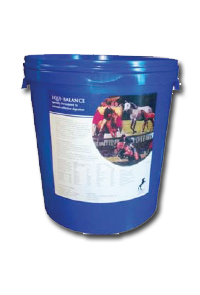
Equi-Balance
PDS Cool Cubes
Stable HF Cubes

